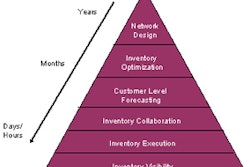
By Gaurang Pandya
Originally focused on matching supply and demand, sales and operations planning (S&OP) now facilitates organizational alignment between business goals and plans, while enabling quick responses to continuously changing business conditions. As organizations are more driven than ever by shareholder expectations, S&OP has a fresh focus: consistent profitability, where the operational plan reliably achieves the financial plan. By adopting the following best practices, an organization can come closer than ever to its objective of consistent profitability.
Focus on cross-functional processes — Having cross-functional processes in place is vital to meeting upper management's goals. Developing the processes to ensure that there is coordination among functions requires executive buy-in and sponsorship. A chief operating officer, general manager or even a CEO is needed to empower the facilitators who will make up the small group to manage process coordination and execution. The cross-functional team is responsible for creating strategic goals and a set of measurements or key performance indicators to support the goals. There must be a process in place with activities and timelines to meet the goals, with clearly defined and assigned roles and responsibilities. Role-based activities ensure that the right person does the job, and agreed-upon data templates guarantee that the necessary data are collected. Adherence to the process is continually measured to map effectiveness.
Synchronized planning models and cycles — To achieve consistent profitability, plans and planning cycles must be linked among finance, sales, marketing, production, engineering and other functions in the organization. Each of the functions analyzes its own capabilities and the levers it has to control adherence to the plan. It shares any changes with the other functions and understands what impacts its plan will have on other plans. For example, a price change impacts volumes and therefore production, requiring changes in inventory plans and production schedules. These changes propagate to the financial plan as well.
Collaboration — Collaboration is critical for consensus between planning and execution. This includes cross-functional collaboration as well as collaboration with customers, suppliers and trading partners. Collaboration is essential for creating realistic stretch goals and a commitment to execution throughout the organization. Organizations have to provide incentives to ensure the accuracy and timeliness of inputs. In return, they can guarantee better service levels, better order lead times and greater flexibility. Then, by measuring the agreed-upon metrics against the trading partners' behaviors, an organization can measure the effectiveness of the collaborative process. These measurements can be used for any necessary renegotiation of terms and conditions.
Proactive monitoring — Consistent profitability can only be achieved if there is a single version of the truth represented in the operational plan, and if it is monitored frequently. To do this, the plan needs to be translated into an execution profile — the rate at which the execution of the plan is anticipated. Then the execution results and metrics need to be matched with this profile to sense deviations and the need for plan adjustments.
Process for constraint management — It is crucial to proactively identify possible constraints in each area of the supply chain. Good constraint management means creating a plan to manage these constraints and to understand their impact on financial performance and avoid lost opportunities. As the constraints change, adjustments are made to the business plan, so that it stays aligned with the financial plan and remains on track for consistent profitability.
Scenario analysis — When alarms are triggered, indicating possible upsets to the plan, there should be a process in place to identify alternative actions. The process compares, analyzes and selects the best alternative scenario and presents recommendations to the designated stake-holders. Financial instruments and optimization tools are used by stakeholders to evaluate different scenarios. Then an alternative can be selected and put into operation to meet the business plan. The scenario construction and evaluation process is consensus-driven. Having a structured scenario analysis leads to well-informed and validated decisions for risk mitigation—an essential component for achieving consistent profitability.
Proactive and empowered management — A measurement system to harmonize efficiency and responsiveness with the business plan is essential in proactive management. Scorecards linked between functions help keep them aligned. By aggregating and disaggregating performance metrics between all levels of all functions, linked scorecards ensure empowerment and accountability. Proactive and empowered management requires a defined process for monitoring forward-looking metrics and clearly notifying the right managers when alarms are signaled. That way the right people are alerted to find the right resolution. The process includes ongoing root-cause analysis to prevent alarms from happening in the first place.
Multi-dimensional organization levers — Organization levers across functional areas are a main factor in making consistent profitability possible. They can be any method or option used for course correction or to accomplish a goal or meet a target; for example, promotions, expediting, adding capacity or demand shaping. Here, it is important that companies identify useful levers associated with each objective or metric, assess the potential impact of the levers on the other objectives and develop the relationship model between the objectives and the levers. It is also important to understand the different lead times needed for the levers to be effective and the probability for each lever to affect the objectives. The key to effective levers is having a well-defined process for applying them: specifically, who can apply the levers, when and under which situations. Best-in-class practice is to construct and use a lever-effective matrix for each functional area or potential problem.
Benefits of consistent profitability
Consistent profitability does more than benefit the bottom line. It also improves overall efficiency in operations and personnel. The new generation of S&OP processes and technology creates shorter cash-to-cash cycles and optimizes capital investments. Because revenue is continuously balanced to cost, and supply matched with demand, an organization consistently meets its financial objectives. This can be achieved because the processes, systems and communications are in place to create organizational efficiency and rapid decision making.
Organizations with such new-generation processes and empowering solutions in place experience improved responsiveness because they have become forward-looking and proactive. They're able to maximize opportunities and minimize the impact of upsets. Process and technology lead to reduced planning cycle times and less information latency. Along with improved decision making, such companies gain a competitive advantage that keeps them at the forefront of their industries.
About the Author: Gaurang Pandya is vice president of i2's Solutions Consulting organization. More information at www.i2.com.
Originally focused on matching supply and demand, sales and operations planning (S&OP) now facilitates organizational alignment between business goals and plans, while enabling quick responses to continuously changing business conditions. As organizations are more driven than ever by shareholder expectations, S&OP has a fresh focus: consistent profitability, where the operational plan reliably achieves the financial plan. By adopting the following best practices, an organization can come closer than ever to its objective of consistent profitability.
Focus on cross-functional processes — Having cross-functional processes in place is vital to meeting upper management's goals. Developing the processes to ensure that there is coordination among functions requires executive buy-in and sponsorship. A chief operating officer, general manager or even a CEO is needed to empower the facilitators who will make up the small group to manage process coordination and execution. The cross-functional team is responsible for creating strategic goals and a set of measurements or key performance indicators to support the goals. There must be a process in place with activities and timelines to meet the goals, with clearly defined and assigned roles and responsibilities. Role-based activities ensure that the right person does the job, and agreed-upon data templates guarantee that the necessary data are collected. Adherence to the process is continually measured to map effectiveness.
Synchronized planning models and cycles — To achieve consistent profitability, plans and planning cycles must be linked among finance, sales, marketing, production, engineering and other functions in the organization. Each of the functions analyzes its own capabilities and the levers it has to control adherence to the plan. It shares any changes with the other functions and understands what impacts its plan will have on other plans. For example, a price change impacts volumes and therefore production, requiring changes in inventory plans and production schedules. These changes propagate to the financial plan as well.
Collaboration — Collaboration is critical for consensus between planning and execution. This includes cross-functional collaboration as well as collaboration with customers, suppliers and trading partners. Collaboration is essential for creating realistic stretch goals and a commitment to execution throughout the organization. Organizations have to provide incentives to ensure the accuracy and timeliness of inputs. In return, they can guarantee better service levels, better order lead times and greater flexibility. Then, by measuring the agreed-upon metrics against the trading partners' behaviors, an organization can measure the effectiveness of the collaborative process. These measurements can be used for any necessary renegotiation of terms and conditions.
Proactive monitoring — Consistent profitability can only be achieved if there is a single version of the truth represented in the operational plan, and if it is monitored frequently. To do this, the plan needs to be translated into an execution profile — the rate at which the execution of the plan is anticipated. Then the execution results and metrics need to be matched with this profile to sense deviations and the need for plan adjustments.
Process for constraint management — It is crucial to proactively identify possible constraints in each area of the supply chain. Good constraint management means creating a plan to manage these constraints and to understand their impact on financial performance and avoid lost opportunities. As the constraints change, adjustments are made to the business plan, so that it stays aligned with the financial plan and remains on track for consistent profitability.
Scenario analysis — When alarms are triggered, indicating possible upsets to the plan, there should be a process in place to identify alternative actions. The process compares, analyzes and selects the best alternative scenario and presents recommendations to the designated stake-holders. Financial instruments and optimization tools are used by stakeholders to evaluate different scenarios. Then an alternative can be selected and put into operation to meet the business plan. The scenario construction and evaluation process is consensus-driven. Having a structured scenario analysis leads to well-informed and validated decisions for risk mitigation—an essential component for achieving consistent profitability.
Proactive and empowered management — A measurement system to harmonize efficiency and responsiveness with the business plan is essential in proactive management. Scorecards linked between functions help keep them aligned. By aggregating and disaggregating performance metrics between all levels of all functions, linked scorecards ensure empowerment and accountability. Proactive and empowered management requires a defined process for monitoring forward-looking metrics and clearly notifying the right managers when alarms are signaled. That way the right people are alerted to find the right resolution. The process includes ongoing root-cause analysis to prevent alarms from happening in the first place.
Multi-dimensional organization levers — Organization levers across functional areas are a main factor in making consistent profitability possible. They can be any method or option used for course correction or to accomplish a goal or meet a target; for example, promotions, expediting, adding capacity or demand shaping. Here, it is important that companies identify useful levers associated with each objective or metric, assess the potential impact of the levers on the other objectives and develop the relationship model between the objectives and the levers. It is also important to understand the different lead times needed for the levers to be effective and the probability for each lever to affect the objectives. The key to effective levers is having a well-defined process for applying them: specifically, who can apply the levers, when and under which situations. Best-in-class practice is to construct and use a lever-effective matrix for each functional area or potential problem.
Benefits of consistent profitability
Consistent profitability does more than benefit the bottom line. It also improves overall efficiency in operations and personnel. The new generation of S&OP processes and technology creates shorter cash-to-cash cycles and optimizes capital investments. Because revenue is continuously balanced to cost, and supply matched with demand, an organization consistently meets its financial objectives. This can be achieved because the processes, systems and communications are in place to create organizational efficiency and rapid decision making.
Organizations with such new-generation processes and empowering solutions in place experience improved responsiveness because they have become forward-looking and proactive. They're able to maximize opportunities and minimize the impact of upsets. Process and technology lead to reduced planning cycle times and less information latency. Along with improved decision making, such companies gain a competitive advantage that keeps them at the forefront of their industries.
About the Author: Gaurang Pandya is vice president of i2's Solutions Consulting organization. More information at www.i2.com.


















